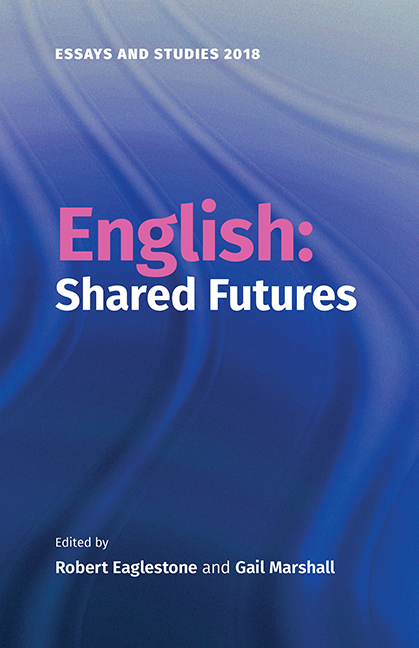Book contents
- Frontmatter
- Contents
- Notes on Contributors
- Acknowledgements
- Abbreviations
- Introduction
- The Changing Picture of School English
- From A-Level to HE: Working Towards a Shared Future?
- English Outreach: Academics in the Classroom
- From Provider to Stager: The Future of Teaching English in HE
- Pedagogic Criticism: An Introduction
- Exquisite Tensions – Narrating the BAME ECA Experience
- Postgraduate Futures: Voices and Views
- Shared Futures: Early Career Academics in English Studies
- Some Reflections on the Funding of English Departments
- English: The Future of Publishing
- Digital Futures
- A View from the United States: The Crisis in the Humanities; the Liberal Arts; and English in the Military Academy
- The Future of Borders
- ‘Between and Across Languages’: Writing in Scotland and Wales
- Exploring Intersections between Creative and Critical Writing: An Interview with Elleke Boehmer
- Integrating English
- Employability in English Studies
- Creative Living: How Creative Writing Courses Help to Prepare for Life-long Careers
- Practice at Large: How Creative Writing can Enhance University Research Environments
- ‘And who can turn away?’ Witnessing a Shared Dystopia
- English and the Public Good
- ‘Can Wisdom be put in a silver rod? / Or Love in a golden bowl?’ On Not Defending the Humanities
- ‘Something Real to Carry Home When Day Is Done’: The Reader in Future
- Afterword
- Index
Some Reflections on the Funding of English Departments
Published online by Cambridge University Press: 15 October 2019
- Frontmatter
- Contents
- Notes on Contributors
- Acknowledgements
- Abbreviations
- Introduction
- The Changing Picture of School English
- From A-Level to HE: Working Towards a Shared Future?
- English Outreach: Academics in the Classroom
- From Provider to Stager: The Future of Teaching English in HE
- Pedagogic Criticism: An Introduction
- Exquisite Tensions – Narrating the BAME ECA Experience
- Postgraduate Futures: Voices and Views
- Shared Futures: Early Career Academics in English Studies
- Some Reflections on the Funding of English Departments
- English: The Future of Publishing
- Digital Futures
- A View from the United States: The Crisis in the Humanities; the Liberal Arts; and English in the Military Academy
- The Future of Borders
- ‘Between and Across Languages’: Writing in Scotland and Wales
- Exploring Intersections between Creative and Critical Writing: An Interview with Elleke Boehmer
- Integrating English
- Employability in English Studies
- Creative Living: How Creative Writing Courses Help to Prepare for Life-long Careers
- Practice at Large: How Creative Writing can Enhance University Research Environments
- ‘And who can turn away?’ Witnessing a Shared Dystopia
- English and the Public Good
- ‘Can Wisdom be put in a silver rod? / Or Love in a golden bowl?’ On Not Defending the Humanities
- ‘Something Real to Carry Home When Day Is Done’: The Reader in Future
- Afterword
- Index
Summary
Why should academics in English take an interest in the funding of their discipline? The answer may be obvious. But in practice, even at quite senior level, I've observed, few follow matters to any depth. This is perhaps understandable as little effort is generally made to make this sort of information widely or accessibly known while, as a whole, we make little effort to follow it. As a result, headline issues such as student fees, or limited postgraduate funding, or ‘marketised’ higher education, consume our attention, sometimes separating them from broader patterns. The deep political and ethical resonance of such issues is naturally more interesting than quotidian income and expenditure. I have strongly held views about some of these high-level issues, which I will come to, but with the encouragement of the editors I want first to consider the bare bones of HE funding in a discipline like English.
Though different disciplines have them in different ratios, and some (such as medicine) have supplementary sources, university departments have essentially three sources of funding: from teaching, research and other. I will reflect on each. The first is generally called ‘T’-stream funding. This derives from undergraduate and postgraduate teaching for which a fee is charged. The UK and EU undergraduate fee is notionally variable, and universities could discount it from the capped maximum (currently £9,250 in England) to reflect actual costs or gain market advantage by competing on price. In reality, however, fees cluster in thunderous numbers at the maximum. Past attempts by a small number of publicly funded universities to offer courses at a lower fee to attract more students (thus offsetting lower unit price by larger volume) failed.
Committed to ‘driving value’ (so-called) into the provision, recent administrations have been keen to introduce ‘private’ (for-profit) providers into competition with ‘public’ (not for profit) institutions, hence establishing the market that didn't materialise voluntarily for reasons I will give below. The argument is that this will disrupt what is in effect a cartel at £9,250, thereby lowering costs for students and forcing universities to ‘drive up’ quality to compete.
Things are often ‘driven’ in this theory, but, so far, journey times are slow with little impact except as a theoretical (and ideological) challenge.
- Type
- Chapter
- Information
- English: Shared Futures , pp. 73 - 82Publisher: Boydell & BrewerPrint publication year: 2018

